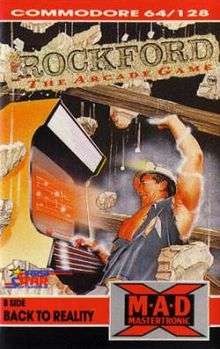Rockford (video game)
Rockford is an arcade game developed by Arcadia Systems as an arcade spin-off of the home computer series Boulder Dash.[1] The original arcade version of Rockford ran on the "Arcadia Multi Select system", an Amiga 500-based system that supported multiple games.[1]
| Rockford | |
|---|---|
 | |
| Publisher(s) | Mastertronic |
| Designer(s) | Peter Liepa |
| Platform(s) | Arcade, Amstrad CPC, Commodore 64, Amiga, Atari ST, Atari 8-bit, IBM PC, ZX Spectrum |
| Release | 1988 |
In 1988, Rockford was ported back to the Atari ST, Amiga, Commodore 64, Atari 8-bit family, and IBM PC compatibles.
Plot
The player is on a treasure hunt, and visits five worlds to collect treasures without getting crushed by giant rocks,[2] boxing himself in, getting caught by enemies or running out of time. Once the required amount of treasure is collected, the player must locate the exit door to finish the level.
The Explorer
Gold coins must be collected. Enemies here are bats and evil monkeys. Killing a bat will give 9 coins. One level features a giant snake, which can turn evil monkeys to stones and stones to gold coins.
The Cook
This food-themed world consists oranges (or rolls) as stones, and apples as treasures. The enemies are sandwiches and fried eggs. Killing a sandwich gives 9 apples. This world features two types of sausages - a good sausage, which turns fried eggs into oranges and oranges into apples, and an evil rotten sausage which does the polar opposite. One level features a clock collectible, which gives additional time.
The Cowboy
Stones are cacti here, and red rubys are collectibles. Enemies include geologic hammers and Colt Woodsman revolvers. Hammers give 9 rubys when killed. The final level has a colonist wagon which turns cacti into rubys and cold woodsman revolvers into cacti. This worlds' clock powerups are bugged and won't increase overall time.
The Cosmonaut
Cosmonaut players must collect suns, and Earth globes function as stones. Enemies are mainly evil black holes, but at one level, strange dinosaur-like space-doves appear, which give out 9 suns when killed. This particular level is also notable for a boiling and expanding plasma-like substance which kills enemies when they're in its close proximity, while growing even bigger. At the end, the whole mass may eventually turn into suns or Earth globes.
The Doctor
Hearts must be collected here, eyeballs serve as stones. Enemies include skulls, and palette-swapped butterflies (these give out hearts when killed). Two worm-like characters will also appear here: a bony one, which turns hearts to eyeballs and eyeballs to skulls, and a healthy meaty one which turns skulls back to eyeballs and eyeballs to hearts.
Gameplay
Rockford is an action arcade game counterpart to Boulder Dash. The game has four difficulty levels, 80 screens, and digitized sound effects.[2]
The player must collect the designated amount of treasure items before he could leave the area and proceed to the next level. Every world features 4 levels, making it 20 levels altogether. The player dies if a stone or a treasure item falls onto him, collides or touches an enemy (even brushing against is enough for the kill), or runs out of time. The player must also watch out not to get himself or the exit locked. The player can kill enemies to break through walls and to obtain the desired amount of treasures.
There are several special characters and contraptions to assist the player, such as faucets, clocks, plasma walls and worm-like creatures.
This game has two distinct versions - one version offers unlimited lives, whereas the other gives 4 lives to the player upon starting a world, and an extra life is awarded after every 20000 points. Points are earned by collecting treasure items and racing the clock.
Reception
The game was reviewed in 1989 in Dragon #141 by Hartley, Patricia, and Kirk Lesser in "The Role of Computers" column. The reviewers gave the game 41⁄2 out of 5 stars.[2]
References
- http://www.amigahistory.co.uk/arcadia.html
- Lesser, Hartley; Lesser, Patricia; Lesser, Kirk (January 1989). "The Role of Computers". Dragon (141): 72–78.